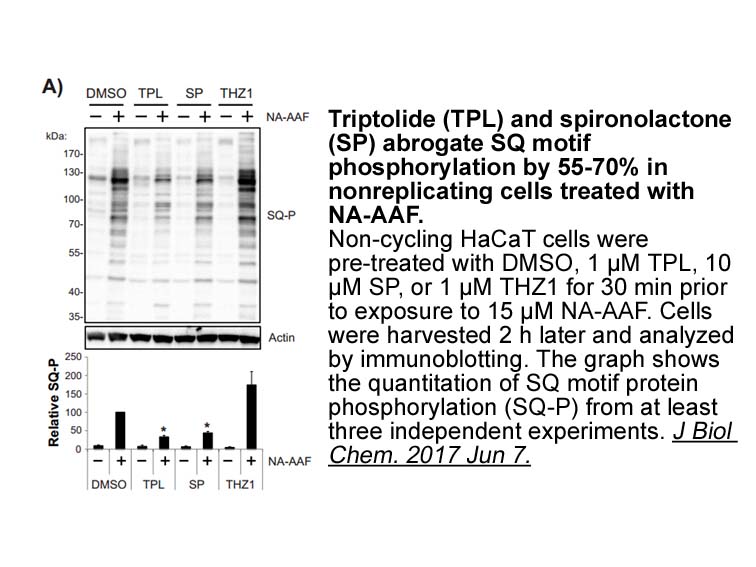Archives
Two primary members of the TRIM family TRIM
Two primary members of the TRIM family – TRIM5α and TRIM25 – function as antiviral effector and immune regulator, respectively. TRIM5α is one of the best characterized members of the TRIM family (both structurally and functionally) and reported to be an important ubiquitin-mediated regulator of a major kinase complex consisting of transforming growth factor-β activated kinase 1 (TAK1) and TAK1-binding proteins (TABs) [74]. In turn, TAK1-TAB complex activates another heteromeric kinase complex IKKα-IKKβ-NEMO that facilitates ubiquination and degradation of NF-κB inhibitor IκBα. Resulting NF-κB upregulation and nuclear translocation drives production of IFNβ and various pro-inflammatory cytokines. TRIM5α also functions as viral restriction factor – it recognizes HIV-1 Tazobactam sodium salt and facilitates its disassembly, in this way blocking the retroviral infection [75]. Here, SPRY domain of TRIM5α specifically interacts with retroviral capsid lattice and induces NF-κB-dependent pro-inflammatory response leading to autophagy-mediated capsid degradation.
TRIM25, another major member of the family, is crucial for antiviral immune response associated with IFN signaling. TRIM25 mediates K63-linked ubiquitination and activation of RIG-I that further leads to upr egulation of IFNβ [76]. As an example, influenza A virus NS1 targets TRIM25 activity to suppress IFNβ-mediated immune response and avoid recognition by RIG-I, the host sensor of viral RNA. RIG-I ubiquitination by TRIM25 results in activation of RIG-I/MAVS signaling pathway and induction of type I interferon in response to viral infection.
TRIM21 performs regulatory functions in both physiological and pathological immune responses, and was proposed as another potential target in SLE [77]. TRIM21 overexpression can result in breakdown of immune tolerance that triggers generation of TRIM21 auto-antibodies in genetically susceptible SLE patients [78]. In addition, patients with SLE and Sjogren\'s syndrome were demonstrated to have increased levels of TRIM21 that enables induction of autoimmune B and T cell responses [79]. The humoral immune response engages TRIM21 as cytosolic antibody receptor that interacts with immunoglobulins at the surface of internalized pathogens and facilitates propagation of diverse immune signals, i.e. TAK-1-dependent NF-κB activation [80].
Among other members of the TRIM family worth mentioning are also TRIM8, TRIM9 and TRIM23 that elicit their immune cellular stimuli primarily through alteration of NF-κB activity. Specifically, TRIM8 poly-ubiquitinates TAK1 resulting in induction of TNFα, IL-1β and activation of NF-κB [81]; TRIM9 stabilizes IκBα and in this way inhibits NF-κB [82]; TRIM23 poly-ubiquitinates NEMO (IKKγ), an important NF-κB regulator, and promotes RIG-I-associated signaling [83].
egulation of IFNβ [76]. As an example, influenza A virus NS1 targets TRIM25 activity to suppress IFNβ-mediated immune response and avoid recognition by RIG-I, the host sensor of viral RNA. RIG-I ubiquitination by TRIM25 results in activation of RIG-I/MAVS signaling pathway and induction of type I interferon in response to viral infection.
TRIM21 performs regulatory functions in both physiological and pathological immune responses, and was proposed as another potential target in SLE [77]. TRIM21 overexpression can result in breakdown of immune tolerance that triggers generation of TRIM21 auto-antibodies in genetically susceptible SLE patients [78]. In addition, patients with SLE and Sjogren\'s syndrome were demonstrated to have increased levels of TRIM21 that enables induction of autoimmune B and T cell responses [79]. The humoral immune response engages TRIM21 as cytosolic antibody receptor that interacts with immunoglobulins at the surface of internalized pathogens and facilitates propagation of diverse immune signals, i.e. TAK-1-dependent NF-κB activation [80].
Among other members of the TRIM family worth mentioning are also TRIM8, TRIM9 and TRIM23 that elicit their immune cellular stimuli primarily through alteration of NF-κB activity. Specifically, TRIM8 poly-ubiquitinates TAK1 resulting in induction of TNFα, IL-1β and activation of NF-κB [81]; TRIM9 stabilizes IκBα and in this way inhibits NF-κB [82]; TRIM23 poly-ubiquitinates NEMO (IKKγ), an important NF-κB regulator, and promotes RIG-I-associated signaling [83].
Small molecule targeting
Drug discovery in the UPS field keeps advancing, driven by foreseeable role of these enzymes as targets in numerous human diseases. Primary examples of FDA approved drugs include 26S proteasome inhibitors Bortezomib (approved in 2003, marketed as Velcade®) and Carfilzomib (approved in 2012, marketed as Kyprolis®) for treatment of multiple myeloma. The emerging and highly promising therapeutic strategy is based on targeting different levels of ubiquitination cascade upstream of proteasome, mainly E1, E2 and E3 enzymes [10]. Here, E3 ligases determine substrate specificity and, therefore, represent primary molecular targets for small molecule modulation. E3 ligases in general, and RING-type E3s in particular, represent lucrative yet highly sophisticated drug targets.
Surprisingly, the apparent complexity of this multi-subunit system might turn out to be an advantage – the multitude of interfaces and pockets provides additional opportunities for design of specific binders. Small molecules have potential to modulate E3 enzyme activity directly by inhibiting substrate/receptor interaction, disrupting enzyme assembly, inducing allosteric conformational shifts that lead to suppressed activity or altered ensemble dynamics [84], stabilizing specific protein-protein interactions within the RING-type E3s complex [85].